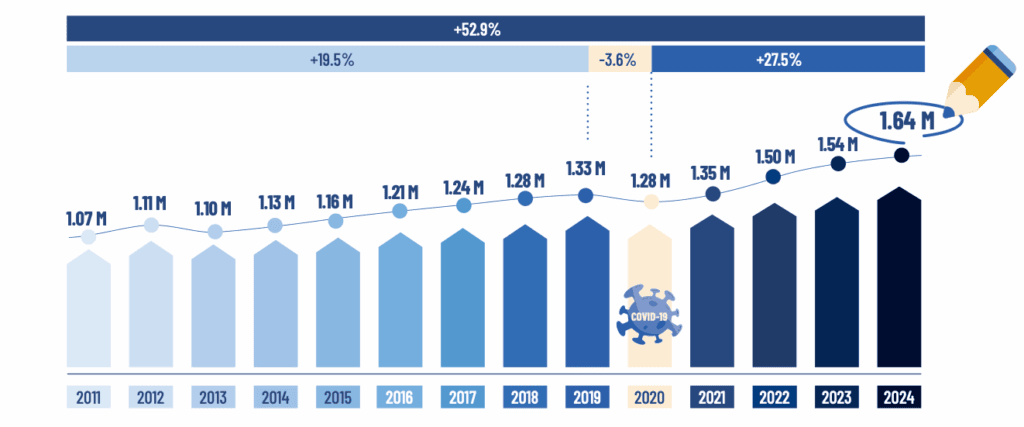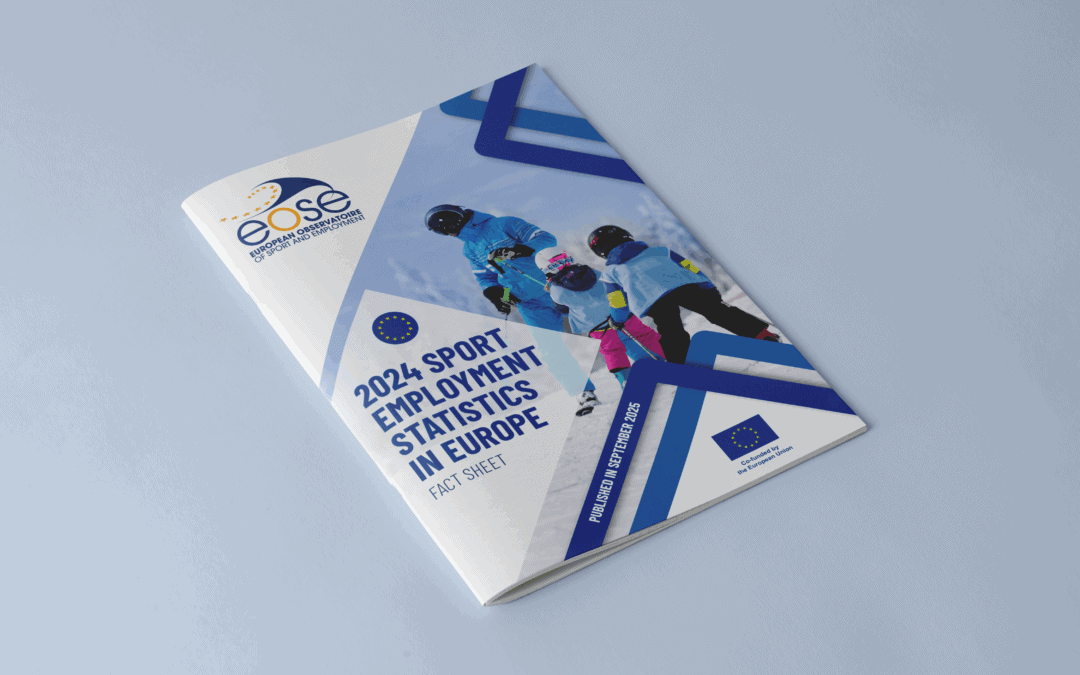We are pleased to inform you that EOSE’s latest statistics on paid employment in the sport sector in Europe covering the years 2011-2024 are now available.
Every year we compile, analyse and publish the available sport employment data collected from Eurostat and national statistics offices and present these in three main categories:
- Total sport employment, which includes:
- Workers with a sport and fitness occupation in sport and non-sport organisations
- People working in organisations whose main business is sport in all occupations
Two documents can be downloaded:
- 2024 Sport Employment Statistics in Europe – Research Report
The latest edition of our annual publication, containing key trends and characteristics of employment in sport from 2011 up to 2024 - An EU Fact Sheet, including visual infographics on the main data points and characteristics
Each document includes data for the three categories – the total number of people employed as well as breakdowns by gender, age, level of education, type of working contract (full-time or part-time), professional status (employed or self-employed), number of jobs held, places of work, types of occupations, etc. This enables readers to see characteristics and realities of sport employment. Where relevant, we include data not just for 2024 but also the trends from 2011.
This year’s edition of the research report includes new data points (e.g. workers with one and more than one job; number of hours worked) as well as national comparisons for EU27 Member States and 5 additional non-EU countries: Iceland, Norway, Switzerland, Türkiye and the United Kingdom. National fact sheets for all countries will be published shortly.
Access the documents through the link below, promote the publication with your network, and read on for a summary of findings.
KEY 2024 SPORT EMPLOYMENT FINDINGS AND TRENDS AT THE EUROPEAN LEVEL
In 2024 sport employment continued grow rapidly overall with a good recovery from the Covid period, but there were national variations.
- Total sport employment in the EU reached a record of 1.64 million in 2024. 1.01 million of these were workers with a sport and fitness occupation, most of whom (53.4%) were employed by sport organisations.

- Since 2011, sport has grown strongly in absolute terms and as a share of total EU employment, now at 0.79% (up 0.22 percentage points), confirming sport employment was still expanding faster (+52.9% since 2011) than the wider EU economy (+10.9%).
- There were wide variations by country: sport’s share of national employment spanned from less than 0.3% in some Member States to well above 1% in others.
- The overall long-term trend was upward despite the Covid-19 dip, with gains since 2020 more than offsetting a -3% decline during the pandemic. However, nine EU countries still have sport employment numbers below those of 2019.
Demographic characteristics of the sector
In 2024 the sport labour force showed a widening gender gap in favour of males. There was a much higher and growing percentage of younger workers (15-24) compared to all sectors, although the share of those aged 50+ is also growing. The relative gender and age imbalances are notable, and there may be clear advantages in attracting and progressing more female workers and boosting the representation of the middle age group by retaining younger workers as they develop in their careers. On a positive note, compared to all EU employment sectors, sport has a higher percentage of workers with graduate level qualifications.
- In 2024 there was a lower share of female employment in sport (43.8%) compared to the EU average for all sectors (46.4%). The gender gap has increased since 2011 when 47.9% were female. In 2024 the representation of females with a sport and fitness occupation and those working in sport organisations was lower still.
- Only 32.4% of managers in sport organisations were female compared to 74% of clerical workers. Females were more likely to be part-time than full-time.
- The workforce was considerably younger than the EU all sector average, with a very large proportion aged 15–24 in the sector (23.5% vs 8.0% in all sectors). Since 2011, there has been a decline in those aged 25-49 with a growth of those aged 50+.
- Educational attainment was relatively high compared with the EU workforce (40.7% with graduate-level education vs 38.6% in all sectors), growing in recent years but with country-by-country variations. There was a higher percentage of females with graduate level qualifications compared to males, and this was particularly strong in workers with a sport and fitness occupation.
Employment status, contracts and multiple jobs
In 2024 the sport workforce had a much higher percentage of part-time contracts, the self-employed and workers with more than one job than the EU average for all sectors. These features can aid entry and responsiveness to demand, but they also raise issues around retention, progression, professionalisation of the sector and social protection.
- Part-time work was much more common (40.8% vs 18.8% in all sectors), especially among females (over 53% of females in sport employment in 2024 were part-time).
- Self-employment was also much higher (22.4% in sport vs 13.7% in all sectors) and has become more prevalent since 2011 (17.9%).
- A significantly higher proportion of workers held more than one job (8.4% in sport vs 4% in all sectors).
- In all cases, there were significant variations country-by-country.


